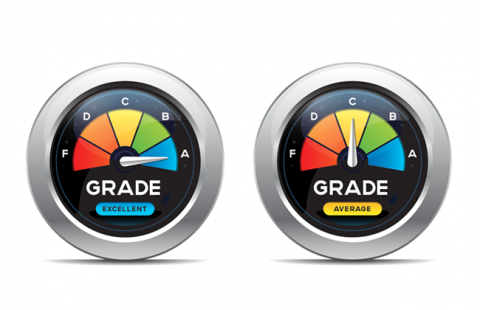In IT we tend to be perfectionists. We strive to get an “A” in everything we do — and we do a lot. But I’ve learned during my years as both an IT leader and a business leader that this kind of thinking can be a trap.
Here’s why. There is a fundamental difference between how IT leaders and business leaders traditionally think. Business leaders tend to recognize that there’s way more work to do than can possibly be done well. So they spend time figuring out the right answers to these questions: “What are the things we have to get an A in, and in what areas is it OK to get a C?”
When IT tries to get an A in everything, it means we’re not focused on things that align with our company’s most critical business goals. By trying to get straight A's all the time, no matter what it is we’re working on, we can end up doing B work across the board — and that’s an unacceptable grade when it comes to our most important goals.
We’ve put this A/C prioritization into practice in our IT team. Like many organizations, we go through an annual goals-setting to figure out what we must accomplish in the upcoming year. But at the end of that process, we sit down as a leadership team and identify the three top priorities — and agree these are the ones where we must get an A.
For everything else we said, it’s OK to earn C's. We’re not encouraging people to do substandard work. Rather, we’re simply making clear that we don’t need to be perfect in areas outside of our top priorities.
Culture change required
Avoiding the “straight A” trap isn’t easy, but it’s necessary. People hear C and think something awful has happened. When we first started down this path, I had to correct people who’d say: “We’re going to get Bs on these other things,” because they couldn’t bear the idea of a C. It was actually kind of an amusing side effect of our approach.
Remember, a C is a passing grade. You did what needed to be done, and you didn’t spend more time than was necessary to get it done. Instead, you invested the lion’s share of your talent and energy in one or more of the team’s top three priorities.
Leadership adjustments
One of my biggest roles in all of this is making sure I am reinforcing the right behavior.
If something goes wrong, if something’s not perfect in one of those areas, my response can’t be, “What the heck is the matter here? We need to get this fixed right away,” If I do, I’m undermining the whole message.
It also doesn’t mean I’m going to look the other way if I see us getting an F. I’ll let the team know an F is not a passing grade and that we need to get the project back to “good enough.”
Real benefits
I’m 100 percent confident that, when we evaluate our IT performance at the end of the year, we will have delivered A-level work on the things that are most important to the business.
That’s because we’re thinking like business leaders. We’re prioritizing what really moves the needle for the company, instead of trying to show how many different things we work on. The CEO already knows that IT does a lot of stuff. Heck, the CEO expects that. What the CEO really wants to know is: What are we doing to drive the company’s top priorities forward? How we answer that question is what really defines IT’s value.







Comments
I whole heartedly agree with the A/C prioritization. The challenge that we see on a daily basis is that our customers/partners have been level set to expect an "A" performance from us. Our customers/partners want what they want, and generally are willing to escalate a given demand to whatever level is needed to assure success. Hence, the delivery of a hamburger (C) would satisfy the business "requirements", a T-Bone Steak (A) is demanded, and usually "A" is delivered as a resolution to the hostage crisis ("We will not adopt if...").
What I am really attempting to say is that our IT level of effort on a given task, is not always within our control without significant change management and support from IT and Business leadership to compromise on a less than "A" level solution.
At my core, I fundamentally disagree with this sentiment.
From a branding perspective, who in the world strives for a "C"?
I believe criteria for success should be negotiated and understood up front to make sure expectations from all parties are known. To imply that "you were used to great service before", but now we're going to give you "good enough" doesn't fly with me if we haven't first agreed on the terms and expectations. If I have the option, I'd be looking elsewhere to see who can give me more for my investment.
I did not receive it as providing par service. My take was that not every solution needs all of the bells and whistles that we are capable of providing. Hence, a top priority (needle mover) may need automation ("A"), but a lower priority can accomplish their requirements with people/process and minor system changes ("B").
We normally set expectations and scope, however the devil lives in the details and it is not plausible to scope to that level. My experience is that it is the lower level details of a solution that drives the highest levels of contention.
Our service excellence must remain a the highest level, but service excellence does not mean giving all customers/partners their every desire, because GBS and Raytheon cannot afford the cost of those solutions.
Tnx
This should not be perceived as saying that subpar performance or service is acceptable. For each thing that an organization (or an individual) does, there is a different "par". And each "par" must be set such that meeting it maximizes value. If set correctly, going above or below "par" will sub-optimize/destroy value. As an analogy, it would probably be sub-optimizing your value to spend days perfectly filing all your credit card receipts from the past five years when you could be instead be making a valuable improvement to your house. So you should strive for a "C" in filing your receipts and an "A" in keeping your home up to date.
But in a large company, it is not this simple. The further employees are removed from the value stream, the harder it can be for them to understand what really creates company value. Thus they end up trying to meet or exceed non-value-add goals, sub-optimizing company value, their own professional value and their job satisfaction. The ideal is for all employees to understand how everything they do creates company value, starting with clear leadership vision and resonating through all management chains.
Thanks Ken, Geoffrey. I 100% get the tongue-in-cheek aspect of the article. However, a "C" is never an acceptable grade for a great company or department. If a "C" is "good enough", we might as well outsource the whole group to a managed service provider that excels at delivering commodity "good enough" services.
As valued business partners, IT can always manage customer and partner expectations by collaborating and evaluating options based on available budget. An "A" is negotiable.
Our Mission & Focus Areas understand EACs, P&L, and the impact of budget challenges. They live and die by the bottom line. Stating we're going to deliver "good enough" services seems patronizing. The programs that rely on IT services understand their financials and business unit financials better than most overhead departments (including IT).